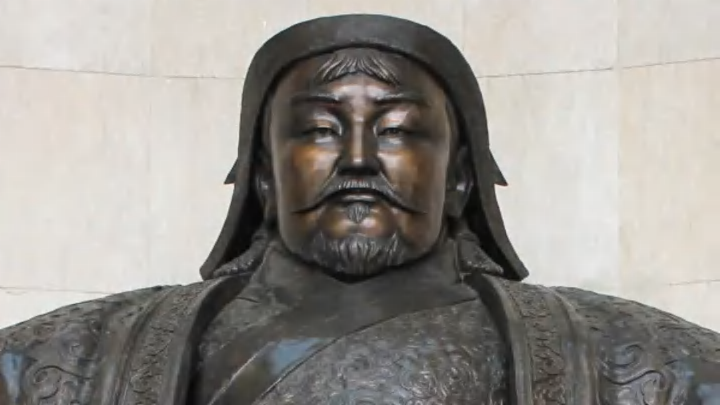MILITARY (1162–1227); KHENTII MOUNTAINS, KHAMAG MONGOL
Of history’s many colorful tyrants, few have captured contemporary imaginations quite like the Mongolian warlord known as Genghis Khan. Assembling disparate tribes to form the world’s largest contiguous army, Khan’s empire eventually dominated nearly 12 million square miles. For more on the man who helped shape the modern world, check out some facts about his death toll, his empire, and his many, many descendants.
1. Genghis Khan’s empire map was vast.

Genghis Khan was remarkable for his time for building armies without regard for religious affiliation and choosing capable leaders for his empire rather than relatives. Once his force was in order, Khan went on a spree of hostile takeovers. Among the lands conquered by Khan and his descendants over a brief, brutal 25-year period:
- China, including Xi Xia, Jin, and Sung
- Iran
- Uzbekistan
- Turkmenistan
- Afghanistan
- Russia
2. Genghis Khan’s childhood was extremely unpleasant.

Thanks to books like Jack Weatherford’s Genghis Khan and the Making of the Modern World (2004) and The Secret History of the Mongols (circa 13th century), certain facets of Khan’s life have come into sharper focus. Born Temujin near the border separating Mongolia and Siberia in 1162, Khan had a difficult childhood. His father was poisoned by an enemy clan, at which point his family’s own clan abandoned Temujin, his mother, and his six siblings. After killing his half-brother, Temujin took over. Once he achieved infamy, he became known as Genghis Khan, or “universal ruler.”
3. Legend says Genghis Khan and his armies killed more than 40 million people.

Thanks to decades of barnstorming across continents, Khan tallied a considerable body count. His armies are believed to have slaughtered upward of 40 million people, though that number comes with an asterisk, as Khan may have exaggerated figures recorded by historians in order to intimidate his foes. Khan’s soldiers utilized a number of tactics that led to their battlefield domination, including feigning a retreat and then returning, catapulting stones and diseased animals over walls, and cutting off water and food supplies to towns.
4. Genghis Khan’s death was anticlimactic.

While suppressing a revolution in the Chinese kingdom of Xi Xia in 1227, Khan died in a military camp. The exact cause is not known but may have been related to injuries he sustained falling off his horse the previous year. If the people of Xi Xia thought they might be granted a respite owing to his death, they were wrong. Before his death, Khan ordered his men to capture the kingdom completely, resulting in widespread death and destruction.
5. No one knows the location of Genghis Khan’s burial site or tomb.

As secretive in death as he was in life, Khan’s final resting place was never recorded. After his death, his heirs held a private funeral procession back to his home of Karakorum and killed anyone who accidentally witnessed it. Khan was then placed in an unmarked grave, which was trampled upon by over 1000 horses to erase any trace of disturbance. Despite historical interest in its location, no one has ever found the site. With Mongolian customs of the time putting people of Xiongnu descent—as Khan potentially was—65 feet below ground in log chambers, no one likely ever will.
6. Thanks to DNA, we know Genghis Khan has a lot of descendants.

The direct heirs of Khan can be difficult to ascertain, but what historians do know about Khan’s descendants often leaves people aghast. Because Khan forced himself upon women following his territorial conquests, it’s been estimated that more than 20,000 births were a result of his lineage in the century following his life. In 2003, researchers found that 16 million men in central Asia shared the same male Y chromosome. While not conclusive proof they’re descended from Khan, it’s strong circumstantial evidence.
7. Genghis Khan’s son and grandson, Kublai Khan, were highly reproductive, as well.

Khan sired a number of children, who in turn took advantage of conquered lands in their own right. His oldest, Tushi, may have had as many as 40 sons of his own. Khan’s grandson, Kublai Khan, was known to have 22 sons.
8. Genghis Khan probably would have hated the Genghis Khan statue.

Khan was infamously reluctant to have his image captured in any way. While he was alive, he never consented to having anyone paint or sculpt his likeness, nor did he want to appear on any currency, making things like his facial features or height hard to substantiate. Today, he’s represented in a number of monuments, but the most famous might be the one located near Ulaanbaatar, the capital of Mongolia. Standing 131 feet tall, the sculpture depicts Khan on horseback and symbolically lording over Europe.
Famous Genghis Khan Quotes
- “I am the flail of god. Had you not created great sins, god would not have sent a punishment like me upon you.”*
* Note: This quote was first attributed to Khan by ancient Persian historian Ata-Malik Juvaini.
